2 RUNNING FREE
FLIGHT TO SUCCESS AND THE NWOBHM, 1979–1980
“I reckon we’re the only real New Wave HM band. ’Cos we’re the only ones who don’t give a monkey’s. We’re an HM band with punk attitudes.”
—Paul Di’Anno, quoted by Garry Bushell,
Sounds, February 23, 1980
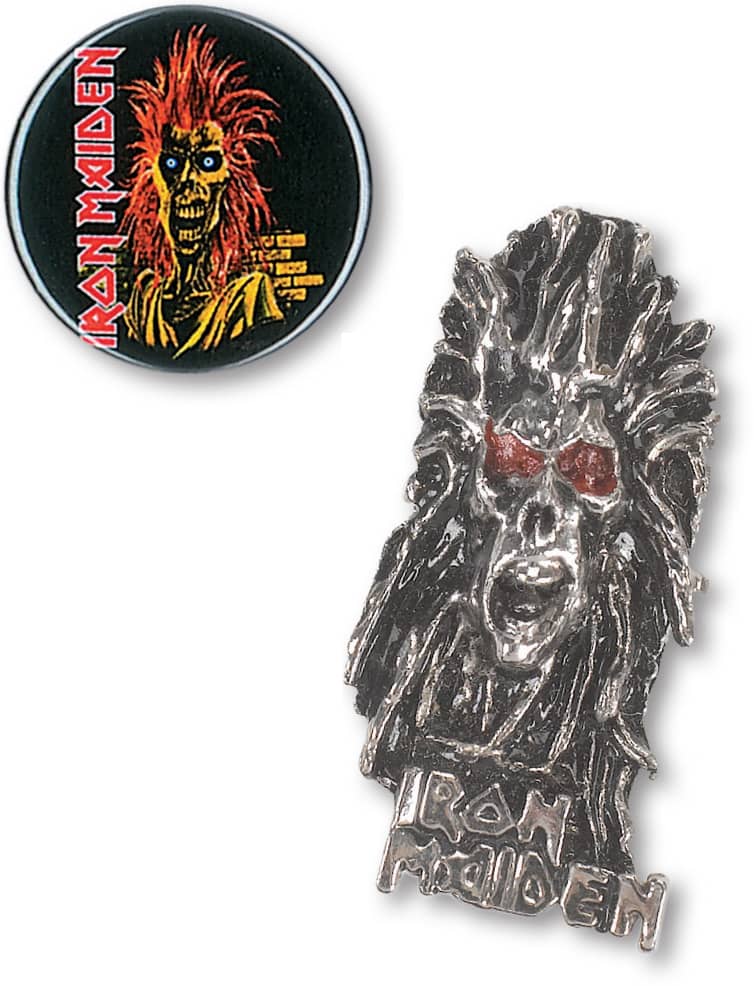
Self-funded and released on the band’s own Rock House Records label, The Soundhouse Tapes EP hit the streets on November 9, 1979, and featured three songs, all culled from the band’s demo, dubbed Spaceward because it was recorded at Spaceward Studios in Cambridge: “Prowler,” “Invasion,” and “Iron Maiden.” A fourth track called “Strange World” was not included because the band was not enthusiastic about its production quality.
The release marked the start of Iron Maiden’s career successes, though they wouldn’t have guessed it at the time. Most of the band members were working day jobs and pouring their hard-earned wages back into the band in the form of gear, petrol, and other gigging expenses.
“We couldn’t actually afford to buy the master tapes, which would have been nice to have now,” Dave Murray told interviewer Gary James (harbinger.org). “We just scraped up enough money to do the recording. But, to actually buy the reel of tape would’ve cost more and we couldn’t afford that. So, unfortunately that’s gone.”
Writing on the website of Spaceward, engineer Mike Kemp confirms: “[W]e were as poor as they were and couldn’t afford to keep £60 multitrack tapes for every band either! (A session cost about that I recall.) We did our best—I think for £5 a week we would hold them until either they were paid for or the band decided not to keep them any longer, e.g. after a remix. Presumably they did not take that option.”
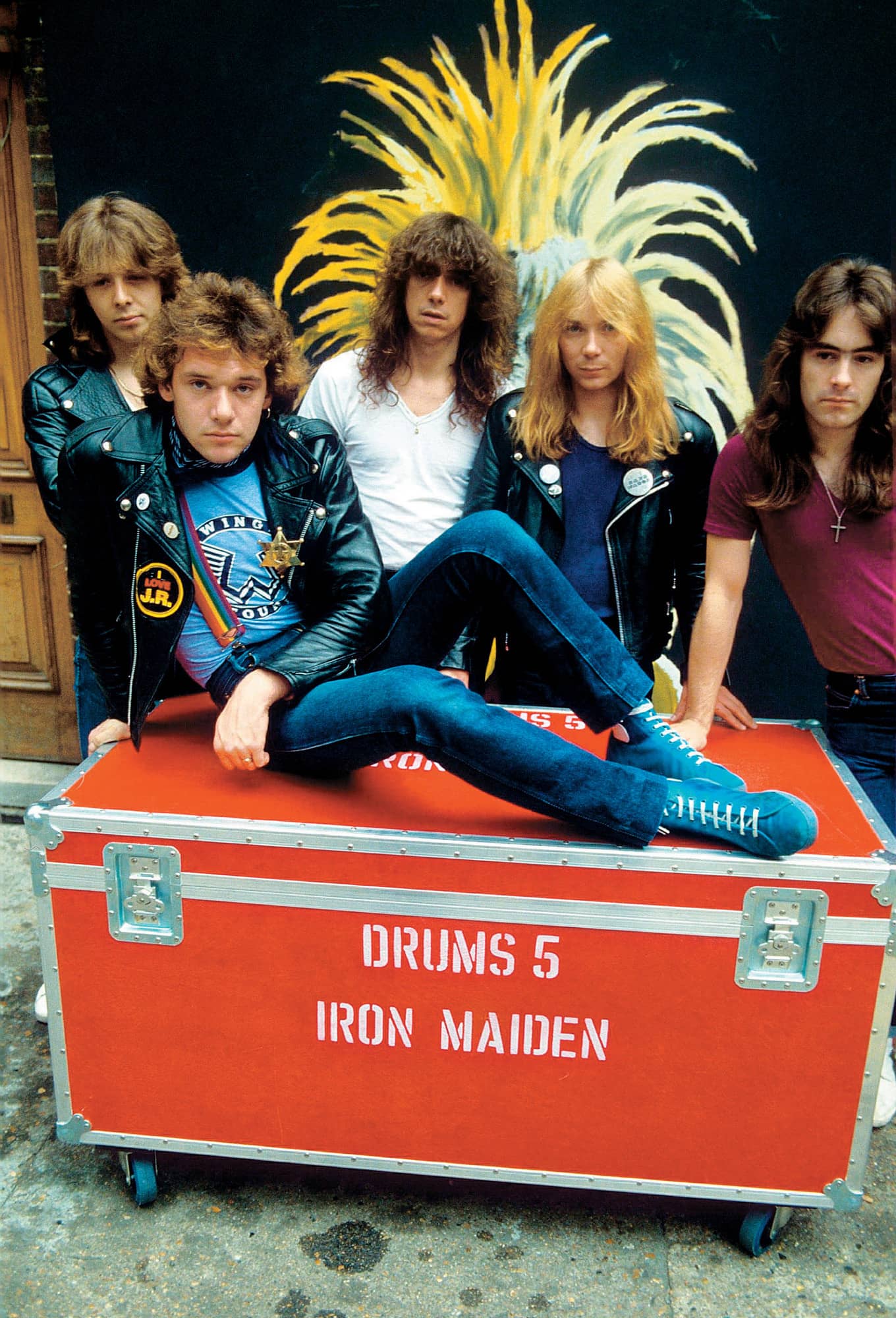
Clive Burr, Paul Di’Anno, Dennis Stratton, Dave Murray, and Steve Harris in 1980. © Presselect/Alamy
The Soundhouse Tapes were named in homage to the Soundhouse Club at the Prince of Wales pub in Kingsbury, North West London, where famed rock DJ Neal Kay ran a heavy metal disco. The EP went on to sell five thousand copies via mail order within just a few weeks. “Prowler” even went to No. 1 on Kay’s Heavy Metal Soundhouse charts in the famed Sounds magazine. It seemed that Maiden was on its way up. At last.
Maiden had the talent and drive to succeed in the business, but those traits would only get them so far. What they needed was somebody with a business brain to get them a record deal, which would, of course, give them the financial backing for their first album. Then The Soundhouse Tapes landed in the hands of Rod Smallwood, the manager and booking agent for Steve Harley & Cockney Rebel. Smallwood and his partner, Andy Taylor, were impressed and signed on as Maiden’s managers. Smallwood was a tough-talking northerner who had the intelligence and fierce wit to get Maiden noticed by record company executives.
The new Maiden line-up was not quite so well settled.
Dave Murray had remained the band’s sole guitarist until Paul Cairns joined sometime in 1979. But Cairns lasted just three months. After attempts with two other guitarists, Paul Todd and Tony Parsons, were aborted due to poor chemistry, Dennis Stratton was hired to join Murray in October 1979. The story goes that Stratton was hired only because Murray’s mate, Adrian Smith, was still busy with Urchin. However, Harris evidently was impressed by Stratton’s work with local band Remus Down Boulevard. Stratton brought with him his friend Clive Burr, who replaced Doug Sampson on drums. There was no way Harris was going to hire any below-par musicians. Now he was comfortable with his band’s second guitarist and drummer.
In 2009, former Iron Maiden drummer Barry “Thunderstick” Purkis, who was in Samson by the time of Maiden’s 1979 personnel changes, told rock scribe Joe Geesin (getreadytorock.com): “They had had trouble with their then drummer, Dougie Sampson, and had decided to part company. I received a phone call over the Christmas period ’79–’80, attended a jam with the band a few days after Christmas, did the proposed single ‘Running Free’ with them, and was asked to rejoin. I spent the whole of the Christmas period deliberating but decided that due to my Thunderstick image taking off [Purkis was on a recent front cover of Sounds], of which Iron Maiden wanted none of, and the fact that I was due to go back into the studios with Samson to record ‘Head On,’ decided that I had taken a different direction. Steve Harris agreed. Imagine my surprise on finding out that the drummer that had been offered the job was none other than Clive Burr. Clive obviously being Samson’s original drummer!”
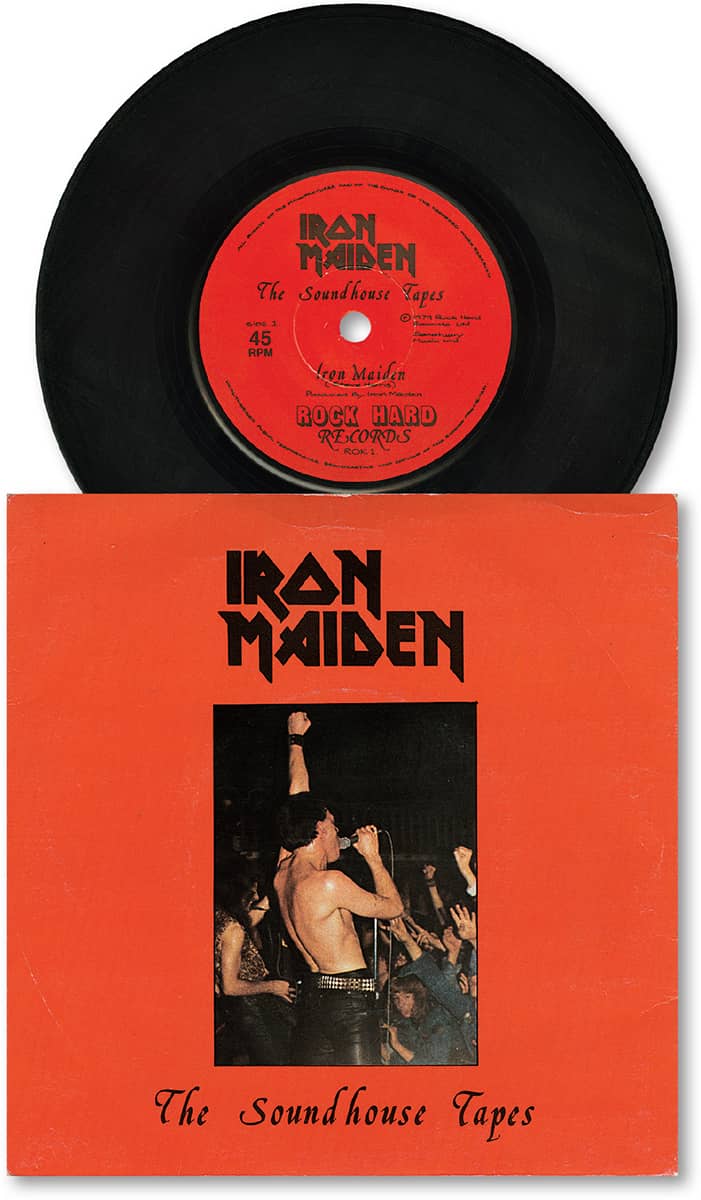
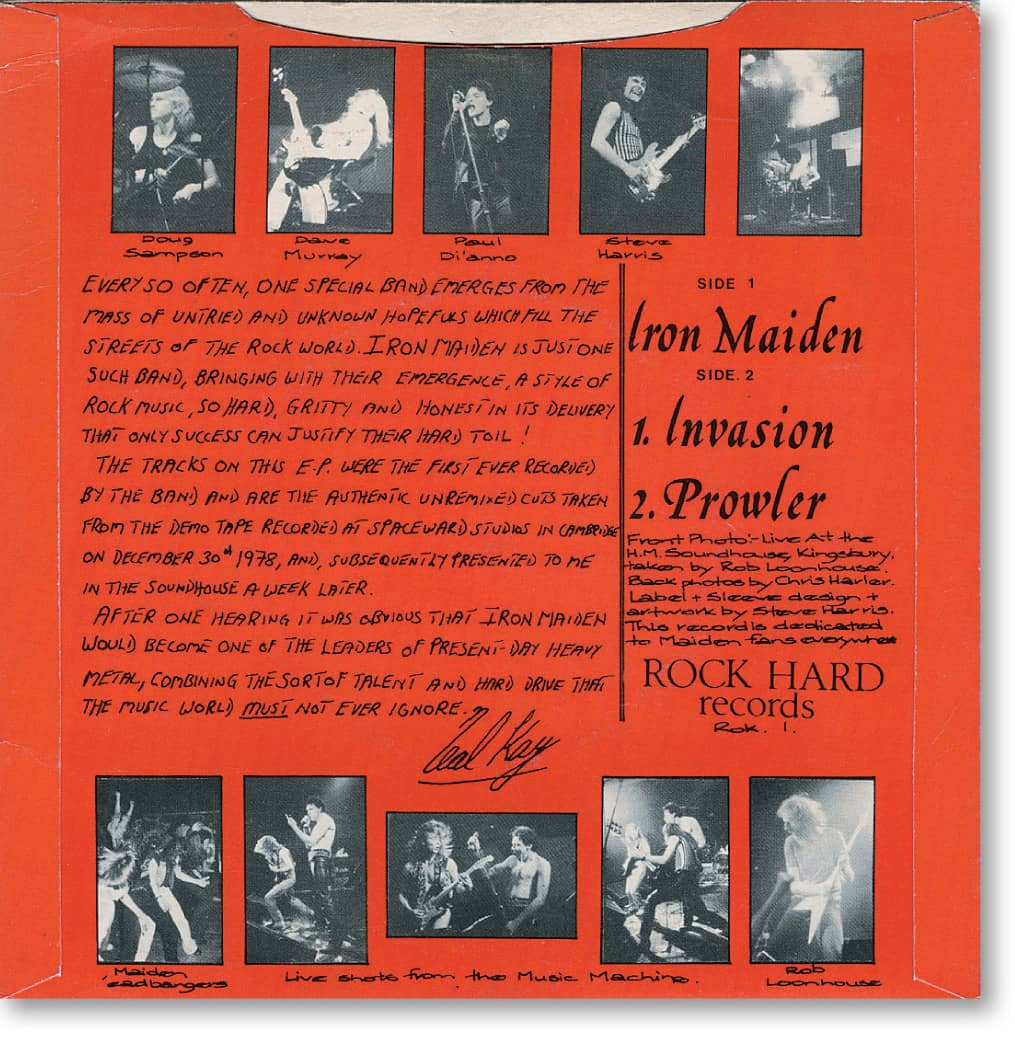
Self-funded and released on Maiden’s Rock House Records label, The Soundhouse Tapes EP hit the streets on November 9, 1979. The seven-inch record featured three songs, all culled from the band’s Spaceward demo.
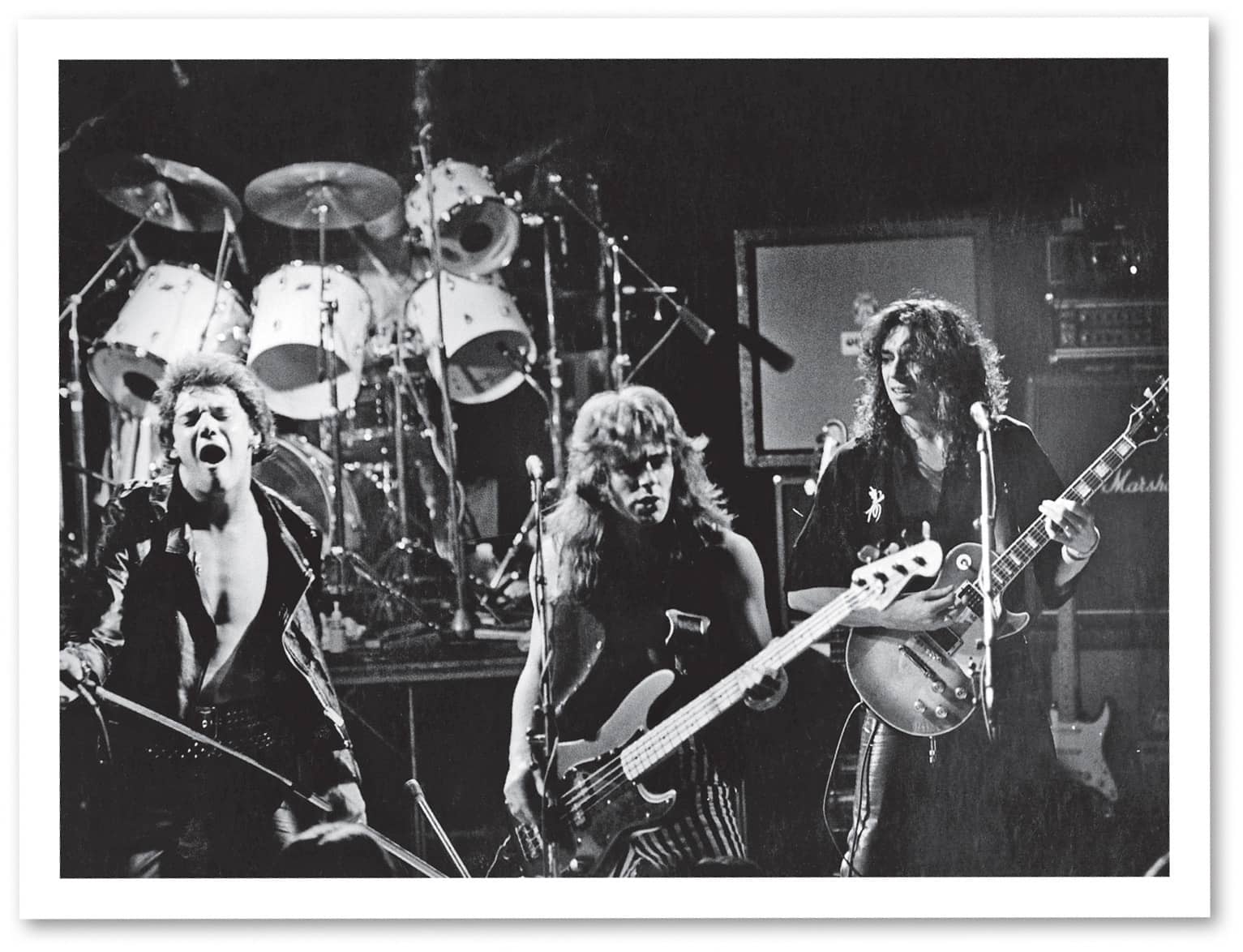
Metal for Muthas tour, the Lyceum, London, February 10, 1980. Both Virginia Turbett/Redferns/Getty Images
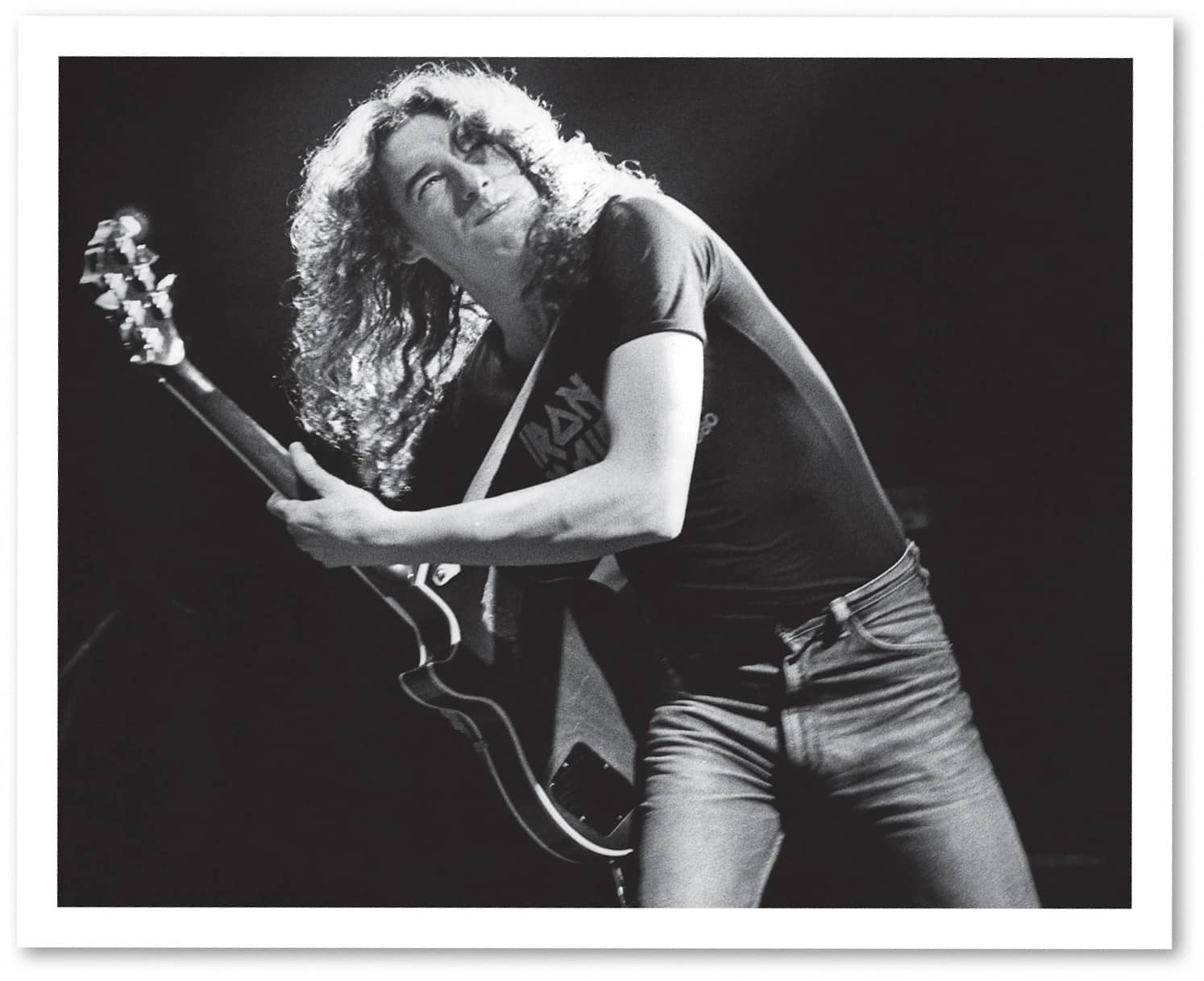
In December 1979 the band finally landed a record deal, hooking up with EMI. The band’s first appearance on an LP, however, came in February 1980, when “Sanctuary” and “Wrathchild” were included on the now legendary Metal for Muthas compilation that also featured contributions from Samson, Sledgehammer, and others. Maiden also committed to a support slot on the equally legendary Metal for Muthas tour, which began at Aberdeen University on February 1 and featured bands from said compilation, as well as Mötörhead and Saxon.
Guitarist Brian Tatler, co-founder of Black Country metallers Diamond Head, remembers the tour’s February 10 London date featuring Maiden and Praying Mantis (both regulars at Neal Kay’s Soundhouse) and his own band, which opened with a short set. “This was an important gig for Diamond Head,” Tatler told me in 2011. “First off, it was in London and, secondly, we knew there would be press there. We arrived at the Lyceum about 6 p.m. and hung around getting worked up and frustrated waiting for Maiden to finish soundchecking. They seemed to take ages doodling our precious time away. At 7:30 the stage manager shouted, ‘The doors are opening’ and Maiden quickly quit the stage and then said to us, ‘OK lads, you can set up now.’ Neither Iron Maiden nor Praying Mantis would move their drum risers, leaving us to play in a straight line with Duncan Scott’s drum kit behind the PA. ‘I was playing to a panel of black wood with jack plugs coming out of it,’ said Duncan. We had thirty minutes to impress and squeezed in four of our very long songs.”
New Wave of British Heavy Metal (NWOBHM) was in full swing, abetted by Neal Kay at his Soundhouse disco and Sounds scribes, such as Alan Lewis and Geoff Barton. At the time, it seemed as though every major U.K. city was producing a healthy—or unhealthy, depending on your musical tastes—number of bands.
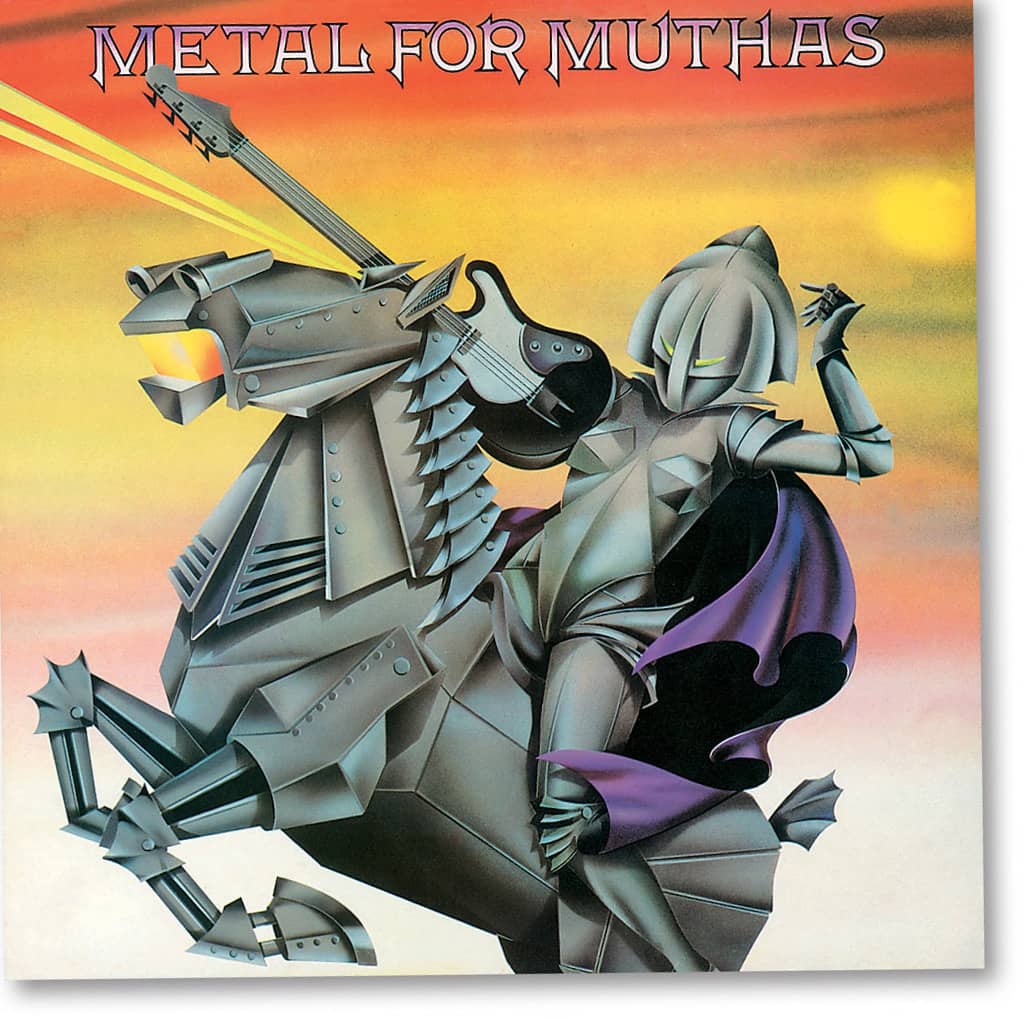
Maiden’s first appearance on an LP came in February 1980 when “Sanctuary” and “Wrathchild” were included on the now legendary Metal for Muthas compilation.
“Well I coined [NWOBHM] as a front-page headline,” Lewis told me in 2010. “But it was sort of an in-joke. We were always hailing something or other as ‘The New Wave of’—it was part of the sense of humor, a bit tongue in cheek. But there is no doubt that we helped to get that whole scene going, and the credit for that goes to Geoff Barton who, along with Pete Makowski, Mick Wall, and Garry Bushell, were celebrating this music when everyone else thought it was a joke. We weren’t as snobbish as the other mags. … I just knew that from a journalistic point of view it generated great copy and great images and connected with readers, and bugger what the pundits thought. But I have to say that it polarized both readers and writers, and caused a lot of internal strife.” With their self-titled debut album, Iron Maiden became one of the genre’s leading bands, along with other heavyweights, such as Saxon and Diamond Head. NWOBHM was certainly in some ways a reaction to punk, but like all the punks bands, NWOBHM bands took a very do-it-yourself approach to the music. The period lasted from 1979 to 1981 and produced a lot of bands, including Bitches Sin, Avenger, Raven, Girlschool, Satan, Blitzkrieg, Trespass, Tygers of Pan Tang, Witchfynde, Aragorn, Atomkraft, Angel Witch, Hellanbach—the list goes on. Despite not sounding like a heavy metal band at all, Def Leppard was also rolled into in the NWOBHM movement. “I don’t think anyone was really aware of it [NWOBHM] until the press started writing about it, and that pretty much started that whole movement,” Steve Harris told Bob Nalbandian in 1998.
Most NWOBHM bands, including Maiden, were inspired by hard rock and heavy metal heavyweights of the early ’70s, namely, Black Sabbath, Judas Priest, Deep Purple, Led Zeppelin, Scorpions, Rainbow, and UFO, among others. And of course the NWOBHM bands would play their part in metal history by influencing thrash bands of the 1980s. But what was it about Iron Maiden that appealed to a much larger audience than their NWOBHM peers? Why did their music travel across the Atlantic, leaving most other NWOBHM bands playing to tiny audiences around the U.K.?
“I think of all the NWOBHM bands Iron Maiden probably worked the hardest, toured the most, had the best manager, and the best record label,” Brian Tatler told me in 2011. “It’s not luck. They had some lucky breaks, but they are consistent with their albums and live shows. They know all about giving the people what they want—you enter into the world of Iron Maiden, it’s like supporting a huge football team. They are one of only a few bands who can fill stadiums anywhere in the world—that takes a lot of commitment. In 1980, I was a little jealous that EMI signed Maiden and Phonogram signed Def Leppard, even though they were right to. I knew that two of the biggest and best labels for breaking rock bands had now snapped up a NWOBHM band, and each and the rest of us were left with labels like Arista, Chrysalis, MCA, and RCA. Rod Smallwood has to take some credit for the huge amount of dedication and energy he put into making EMI and Kerrang! work on Iron Maiden constantly. Iron Maiden must have been in Kerrang! every week for fifteen years!”
In a 2011 interview, original Tygers of Pan Tang singer Jess Cox, from the northeast of England, concurred:
I guess their management was more astute and focused than other NWOBHM managers, who were mostly teachers, postmen, and secondhand car dealers. The press, too, championed them more than any other NWOBHM. Being in London, too, and being local Cockney boys would of helped—they were easily “gottable” by [the] industry, playing the likes of the Marquee as a “local” gig. It was a huge deal to do the Marquee as a Northern band, career-wise and logistically, but Maiden lived in London and were the first NWOBHM band to headline Marquee shows, which was the spiritual home of the NWOBHM.
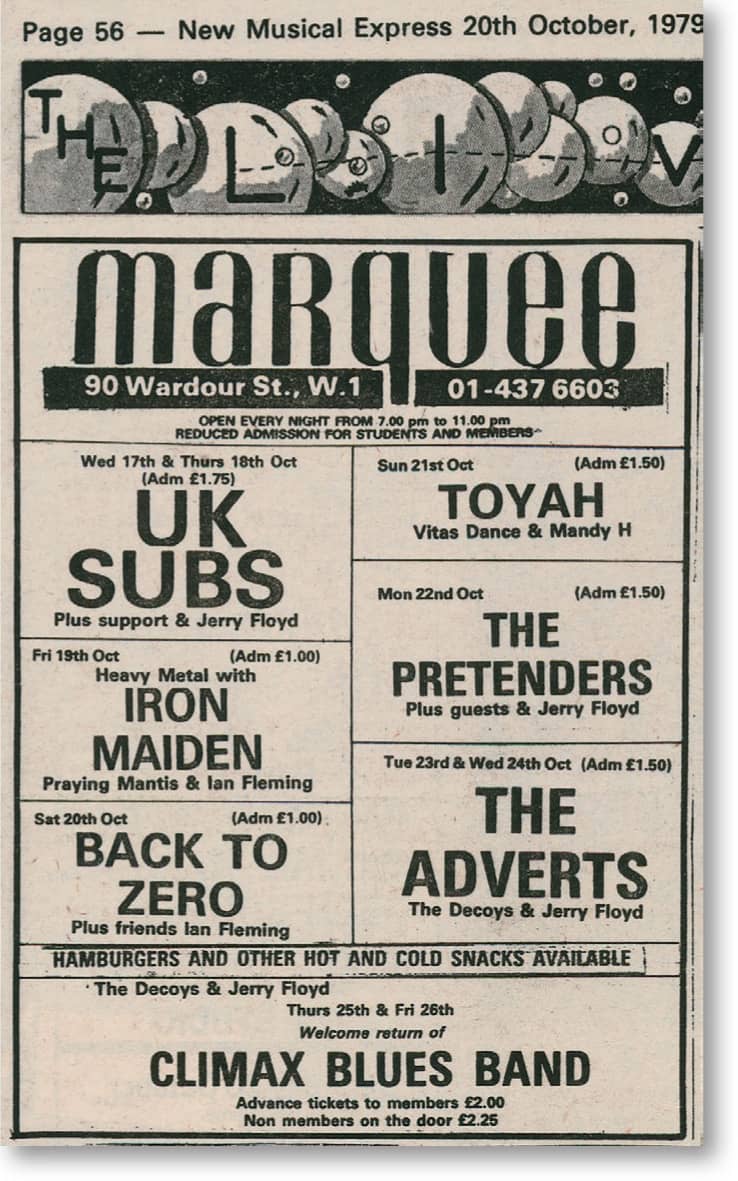
Maiden was the first NWOBHM band to headline Marquee shows, the club which, according to original Tygers of Pan Tang singer Jess Cox, was the spiritual home of the NWOBHM.
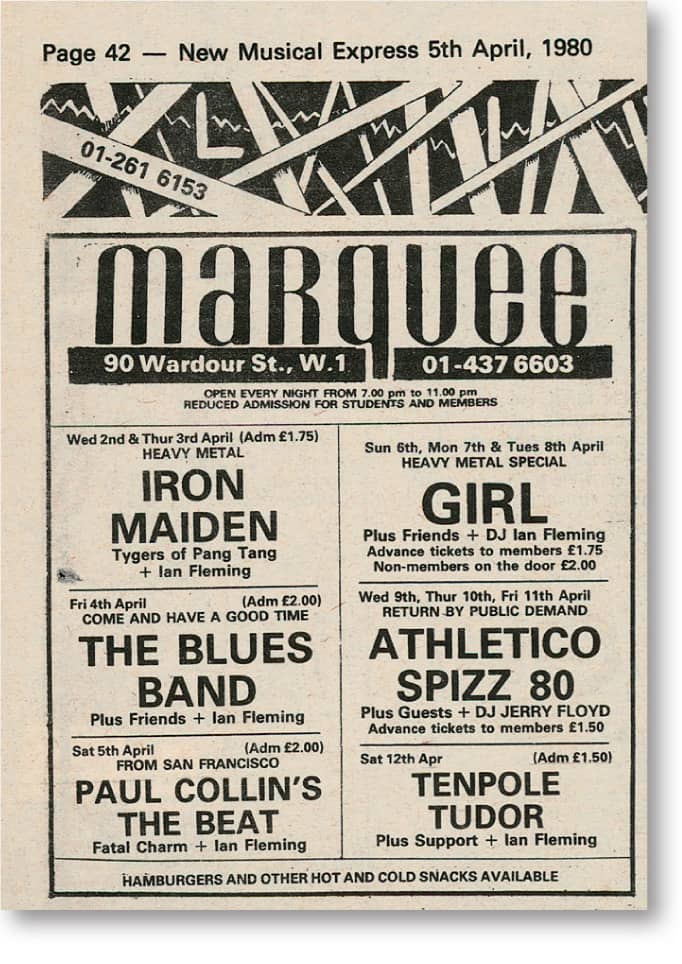
Also, of course let’s not forget their early albums were … phenomenal classic heavy metal, which set them up nicely when all the other NWOBHM bands were breaking up and/or being dropped by the major labels. They went on tour for two years promoting the album, cementing them as the “it” band of the genre. The guys then just gave their then-huge fan base what they wanted. Every album after this was a Maiden album musically and visually, with the Eddie graphic and Union Jack easy symbols for metalheads to want to buy into the Maiden brand. Once they became a machine rolling on with album, tour, album, tour, year after year with no competition, they just steamrollered the scenes and mopped up the fans worldwide.
Released in April 1980 in the United Kingdon and in August in the United States, the band’s self-titled debut with EMI was produced by Will Malone at London’s Kingsway Studios. The story goes that Malone was not totally enthusiastic about the project, and though many longstanding fans continue to like the album’s raw, aggressive, and almost punk-like sound, other quarters of the Maiden fan base believe it sounds somewhat amateurish. It has been claimed that Steve Harris took over most of the album’s production because of Malone’s perceived lack of interest.
The album’s influence on subsequent metal bands, particularly in the United States, cannot be overstated. North American thrash and speed metal bands of the 1980s like Metallica and Megadeth owe a huge debt to the Iron Maiden LP. The marriage of pulsating riffs, galloping bass lines, aggressive vocals, and progressive elements was extraordinary.
However, the punk element and the band’s implied association with the punk scene was not something with which Steve Harris was entirely pleased. “Punk was only important in that we hated it and didn’t want anything to do with it,” he said in an interview appearing on musicrooms.net in 2010. “Punk came out at the time we were doing pub gigs and it was very difficult for us to get work because we didn’t look right. We were around before punk, from ’75, and then, when punk began to really happen in ’77, people started making those comparisons that really annoyed us because we didn’t want them.”
While Harris sided with hard rock bands, Di’Anno was the band’s true punk fan. “We played [heavy metal] ’cause it sounded really fucking good,” the band’s erstwhile singer told fanpop.com in 2009. “We were faster than everybody else’s—we were faster and more complicated. But you know, I like punk music and hardcore, yeah, and most of the heavy metal sound I’m not really a fan of.”
Maiden’s debut album contains some of the band’s most cherished songs, including the seven-minute metal epic “Phantom of the Opera,” early fan favorite, “Sanctuary,” and the instrumental “Transylvania.”
Another was “Charlotte the Harlot,” about which Di’Anno spoke to battlehelm.com. “Her real name is High Hill Lil and she’s basically an old prostitute,” he told interviewer Shan Siva. “Well, actually she was more of a slut. … I mean, if you turned up to her house with some booze or some speed you were more or less guaranteed a lay. She was a legend in Walthamstow, everyone knew her. She was about forty-five but a real rock out bitch. She’d take any guy from fifteen upwards! The song says that she lived on Acacia Avenue but it’s actually Mark-house Road, just before you go into Leyton ’cos that’s the area where I lived.”
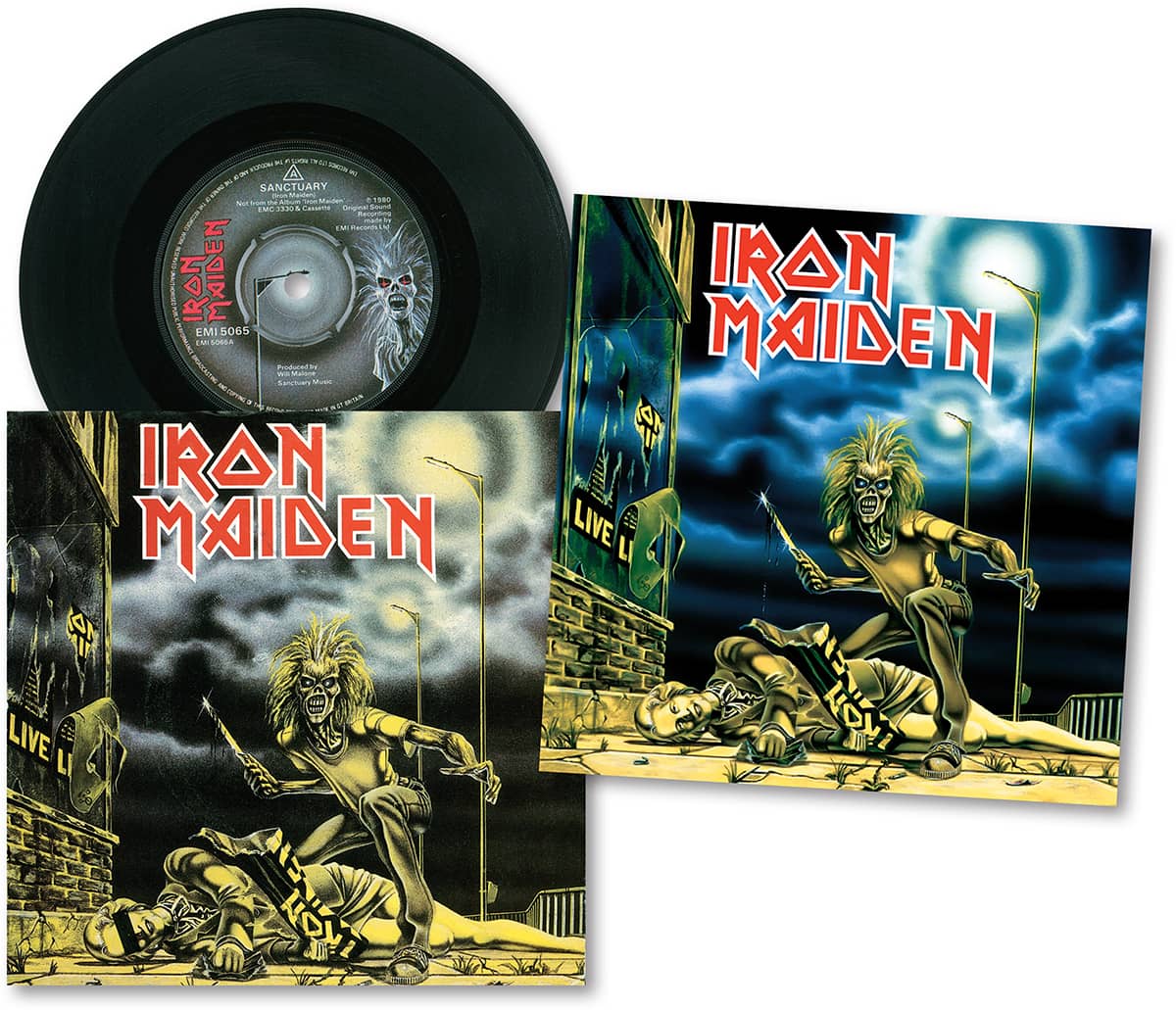
“Sanctuary” (May 1980). The band asked Derek Riggs to draw British Prime Minister Margaret Thatcher’s face on the murder victim as a play on her nickname, “The Iron Lady.” The art was, of course, considered offensive and her eyes were covered with a black box to appease the offended.
The band’s first single off the debut LP was the excellent teenage-rebellion song “Running Free,” which the band performed on legendary U.K. music program Top of the Pops. Maiden was so dedicated to their art that they chose not to lip-synch their performance, becoming the first band to play live on the show since the Who back in 1973.
The sleeve art for both “Running Free” and Iron Maiden featured the first appearance of one of rock’s great icons, the band’s famed mascot Eddie. Interviewed at getreadytoroll.com in 2007, former Maiden lighting engineer Dave “Lights” Beazley explained Eddie’s background:
Eddie the Ed was a joke that was going around at the time, i.e., a couple had a child, but when the child was born it was only a head—no arms, legs, or anything else. The couple were devastated but the doctor said, “Don’t give up hope. When the head’s grown to its full size, which will be when the boy is about fourteen years old, we’ll fix him up with a body.” So the couple put Eddie on the mantlepiece and looked after him for the next fourteen years. On his fourteenth birthday they said to him, “Eddie, we have a very special present for you,” and Eddie replied, “Oh, no … not another fuckin’ hat!” So yes, the idea for Eddie grew out of that joke! So on the backdrop that we used for the pub gigs, with the help of a friend from art college, I rigged up a mask that was made from a mould of my own face, which coughed up blood in time to those lyrics. The Eddie that was used as the band became more famous was designed from artwork by Derek Riggs, but the original idea started with that joke and that first mask. As to whether I see him as family, yes, in a way I suppose I do!
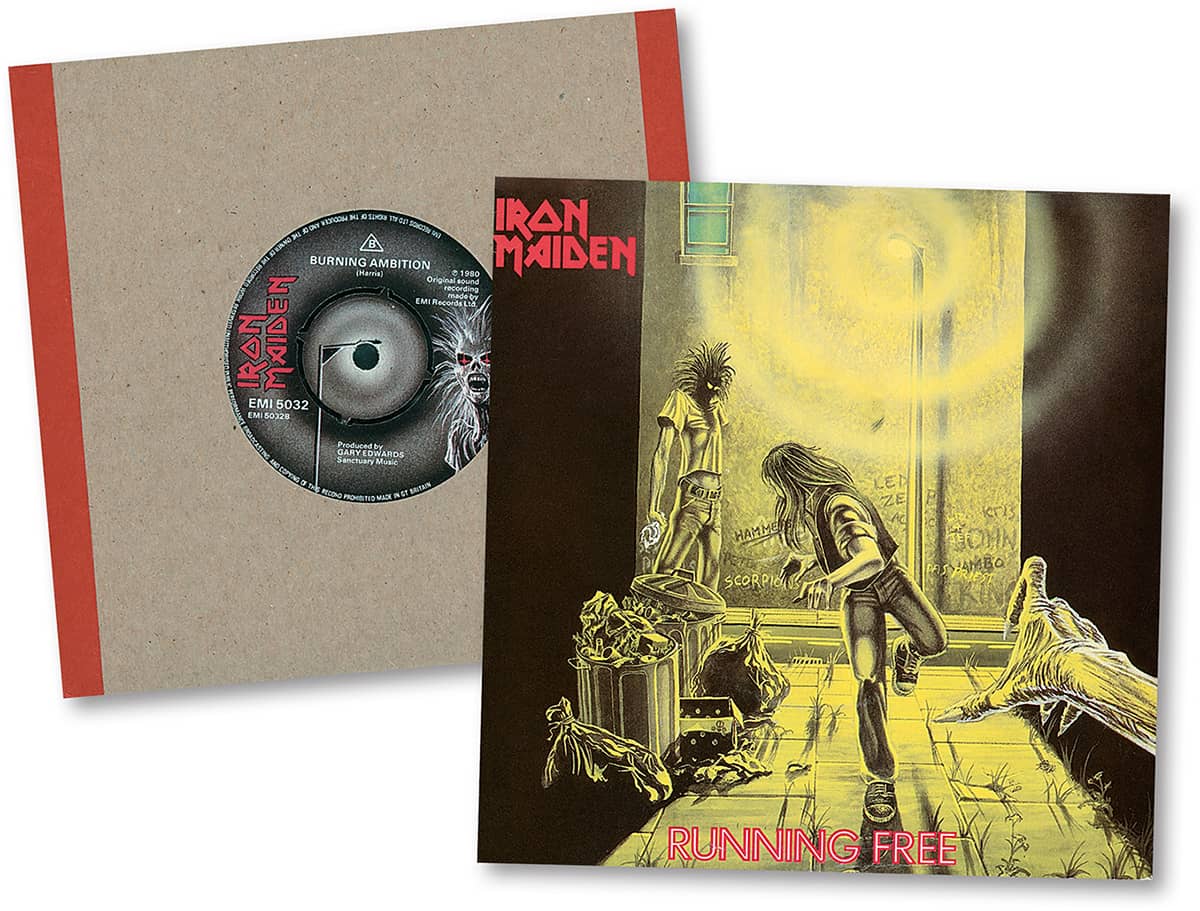
“Running Free” (February 1980).
Even in those early days, Maiden used a lot of backdrops and masks onstage. “I painted the first Eddie backdrop—actually the first three or four—and then I managed to get out of doing them because they were horrible to have to do,” Riggs told Scott Hefflon of lollipop.com. “You end up getting shipped across London to some lonely, cold, wet warehouse with sheets of canvas and a bucket of paint. [Eddie masks] were specially made. They had a few of them. Some of the masks were made by this bloke who made props for television, and a large puppet was made by a guy who did giants for theater productions.”
Graced by Riggs’ Eddie artwork and stacked with fan favorites the band had established by touring the British Isles and gigging closer to home in London, Iron Maiden was a hit, reaching No. 4 on the U.K. album charts and receiving strong reviews in the rock press. “The record company knew the album was gonna do well because of advance orders,” Dennis Stratton told getreadytoroll.com’s Jason Ritchie in 2003, “but it was nice to get great support everywhere we went.”
Steve Harris was not looking back. There was a lot going on in the band, and a successful future was in the making.
On March 7, 1980, Maiden set out in support of self-proclaimed Metal Gods Judas Priest on the U.K. leg of their British Steel tour. The East End lads then launched their own Iron Maiden tour on April 1 at London’s Rainbow Theatre. The tour saw the band all over the United Kingdom (the live cuts on the flip of “Sanctuary” were recorded at the Marquee on April 3) and included a gig at the Ruskin Arms on April 8 in aid of Dr. Barnardo’s, the famous children’s charity. The band displayed an incredible amount of charisma and energy that night, and footage was later included in the exhaustive 2004 Maiden documentary The Early Days. Notably, Di’Anno’s Maiden debut had occurred at the Ruskin back in December 1978. Despite being adored by rock fans the world over, the iconic East End pub closed in 2009.
The tour also brought them to Belgium for their first gig outside of the British Isles, appearing at the Wheel Pop Festival on April 5.
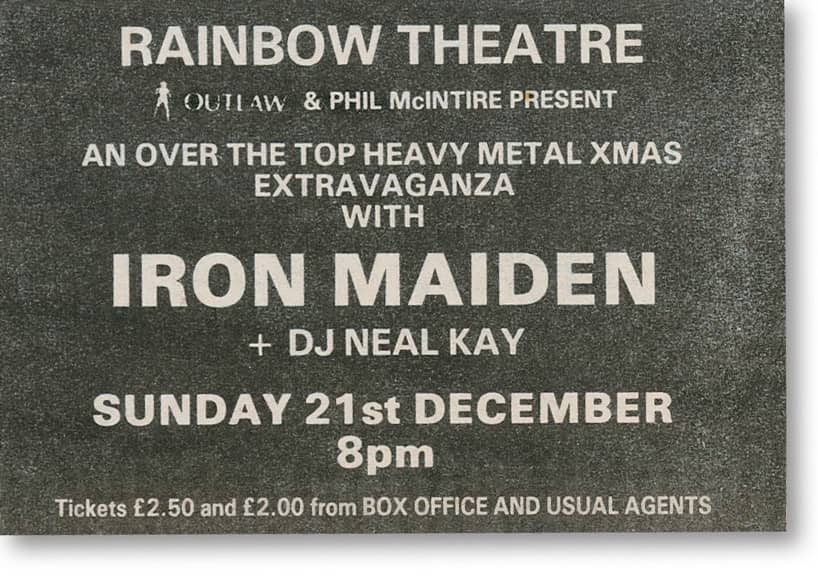
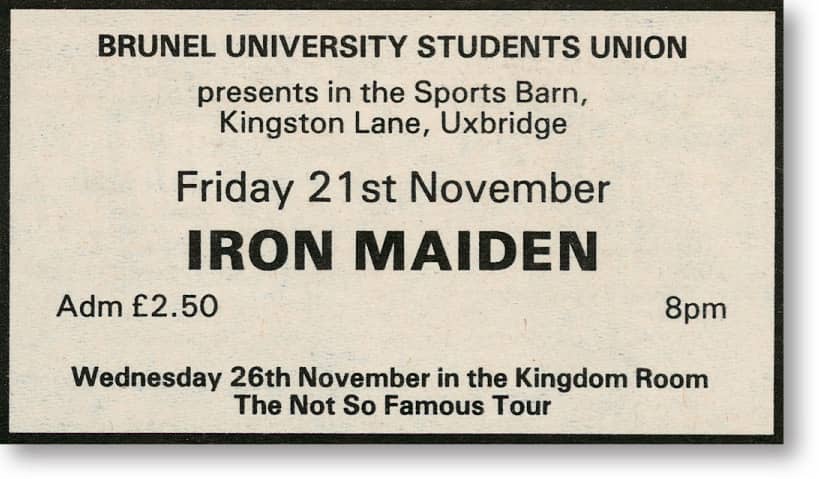
As soon as Maiden’s supporting slot on KISS’s Unmasked European tour came to an end in October 1980, the band carried on with their own headlining tour from November through the end of the year.
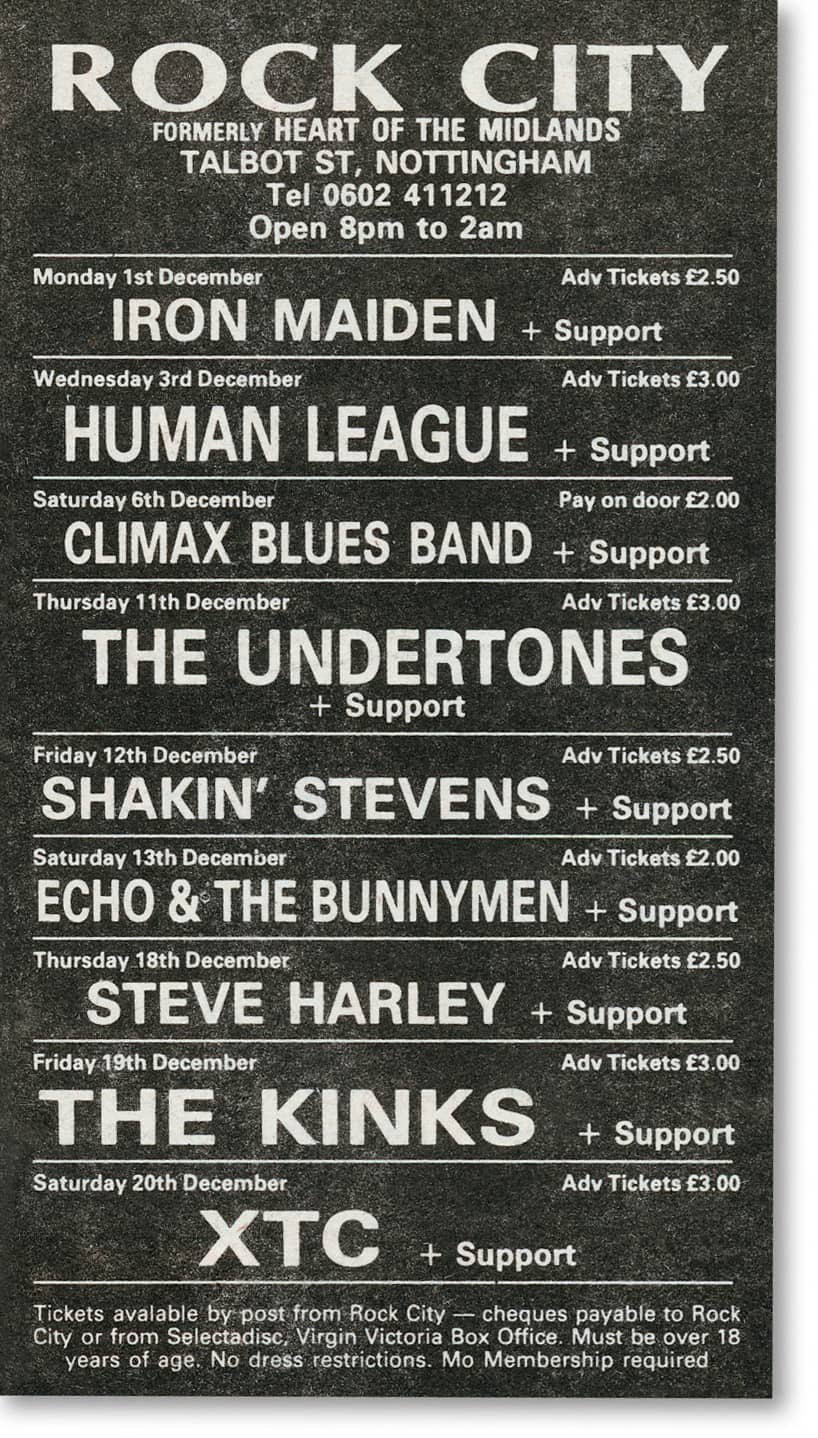
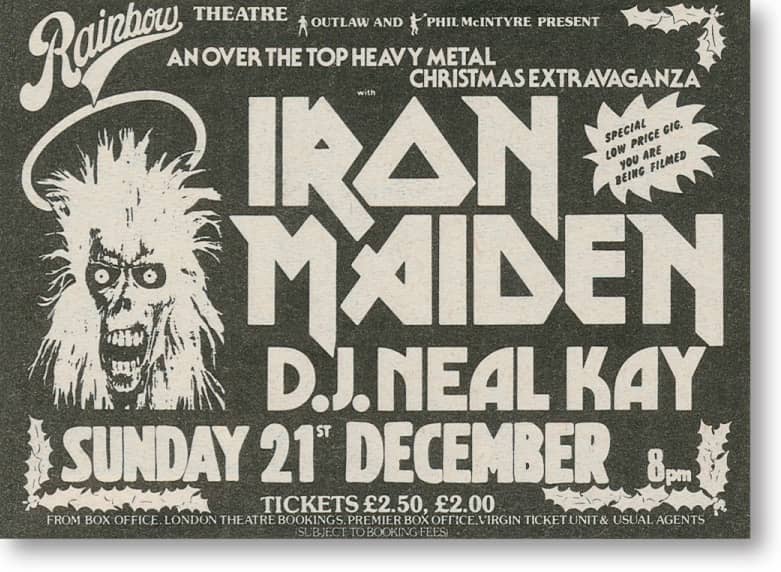
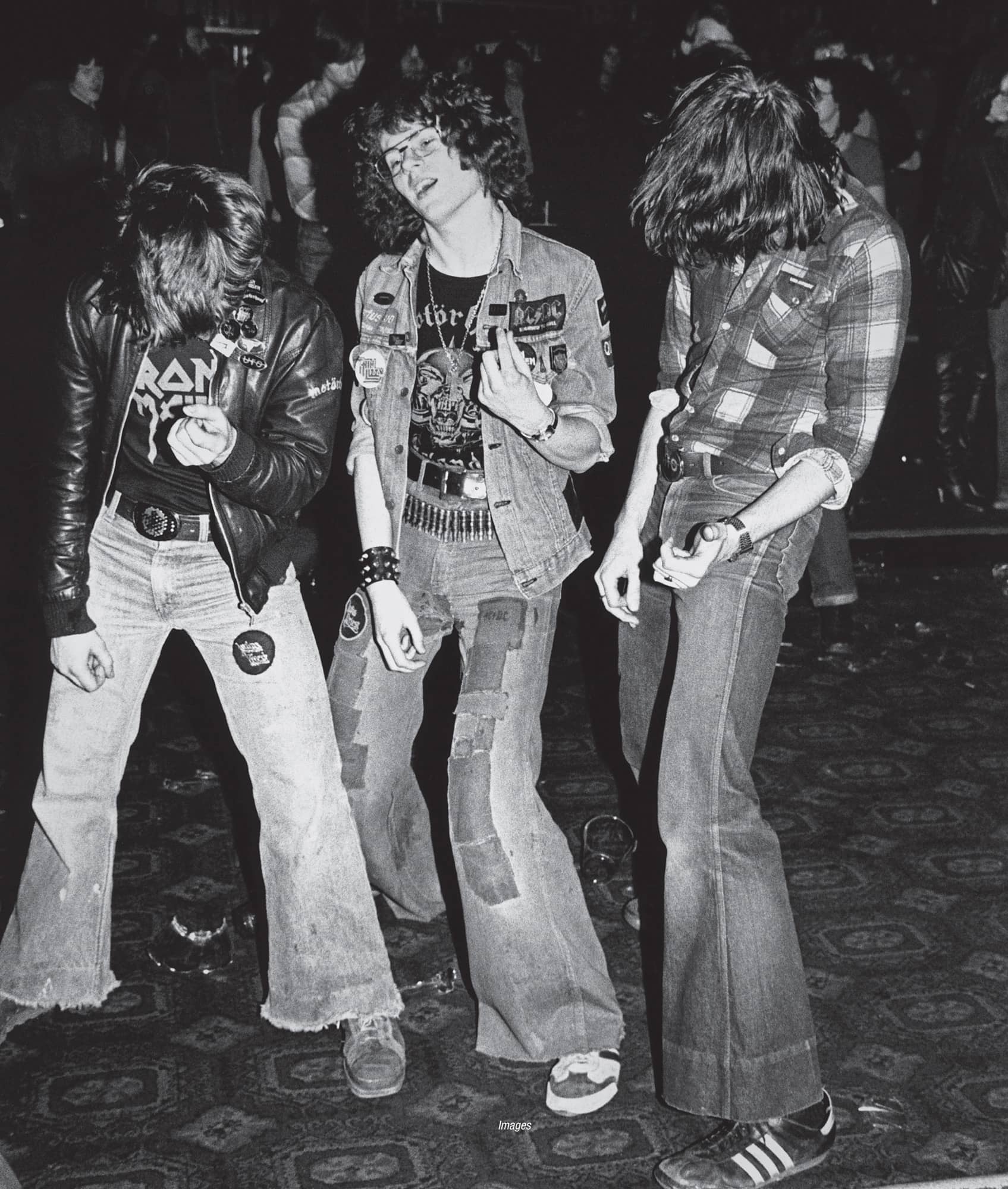
Maiden fans rock the Lyceum, London, February 10, 1980. Virginia Turbett/Redferns/Getty Images
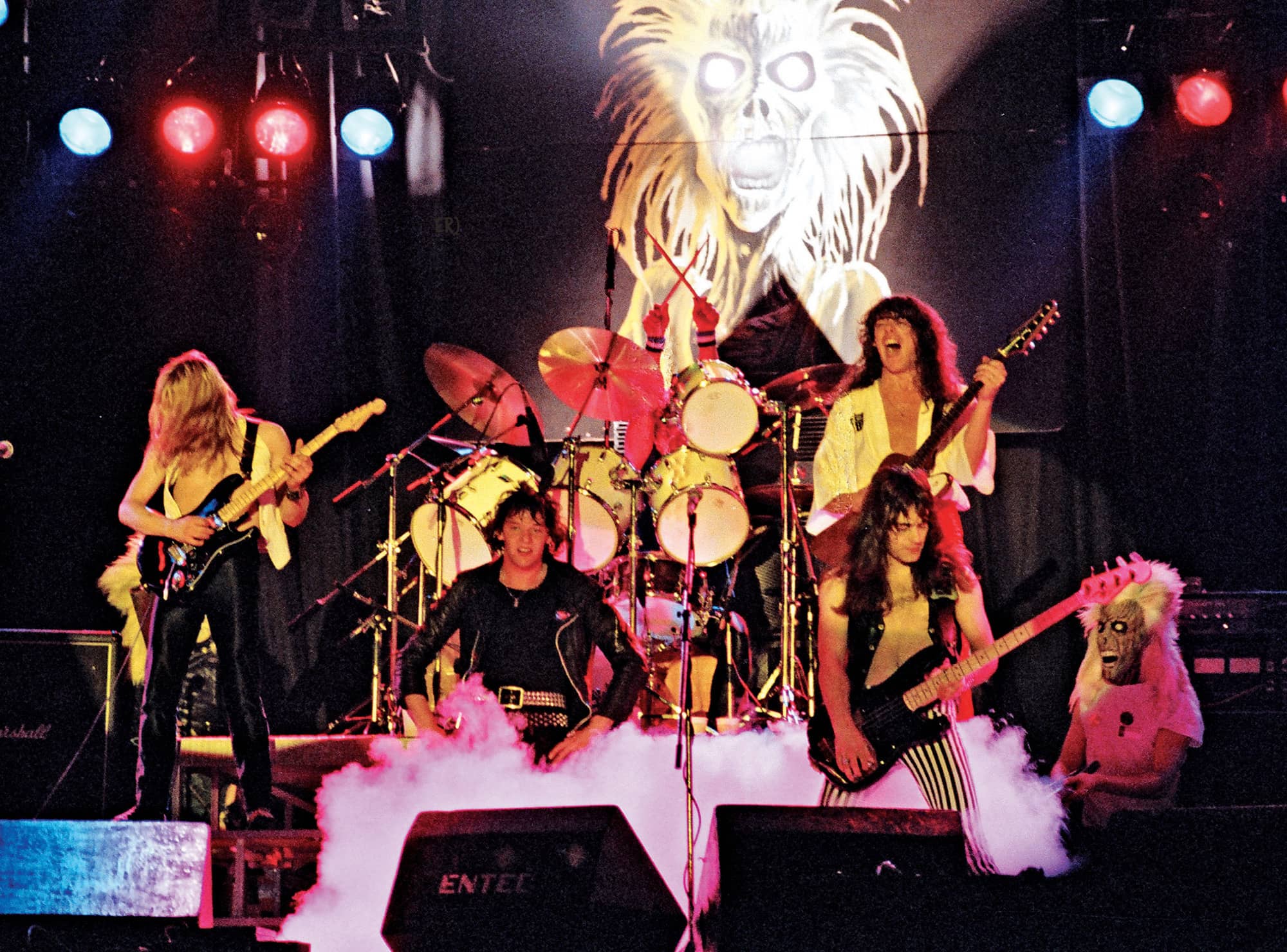
Iron Maiden made their first Reading festival appearance on August 23, 1980. © Alan Perry
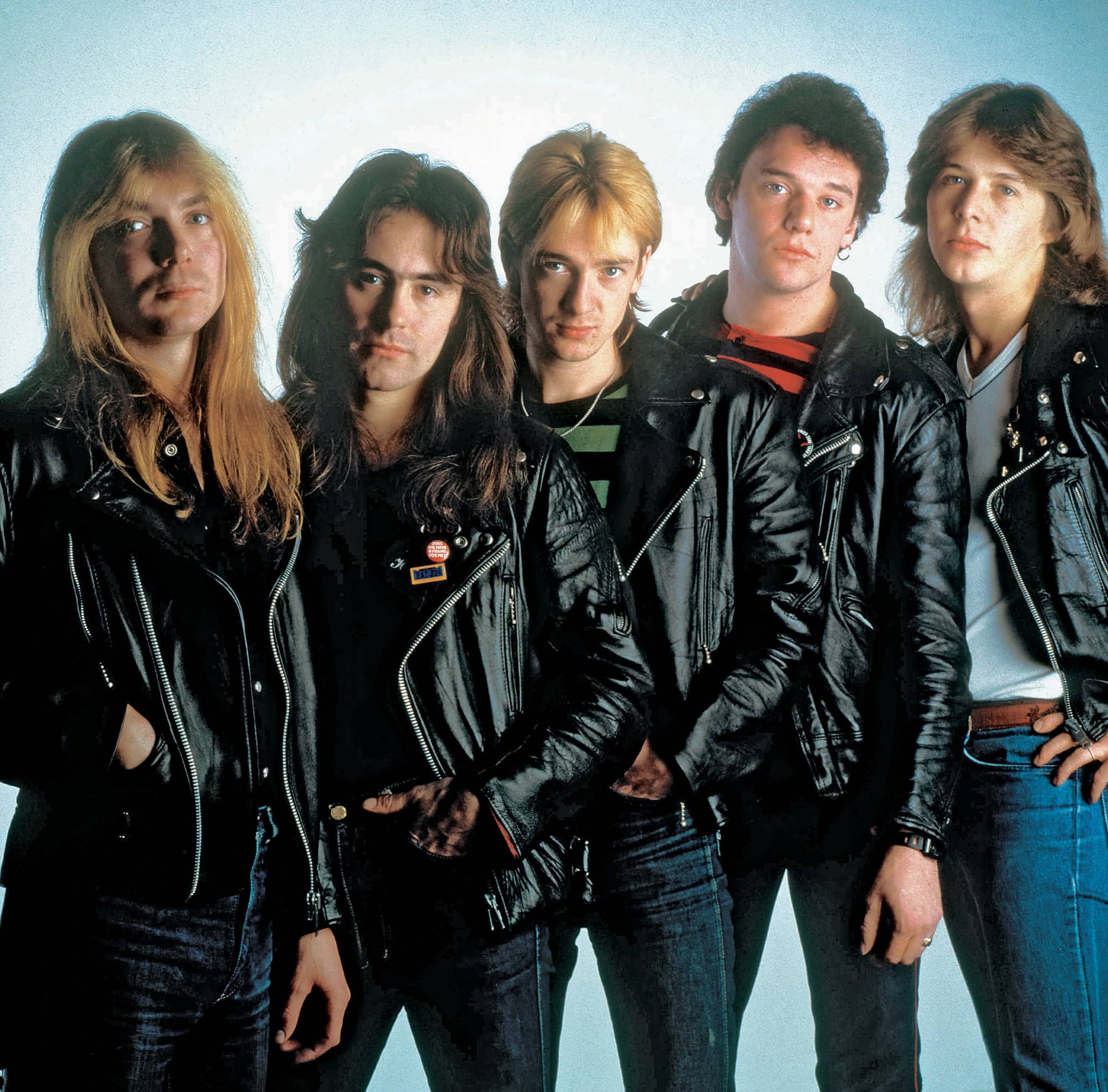
October 1980, shortly after Dave Murray’s old mate, Adrian Smith (center), replaced Dennis Stratton on guitar. Gered Mankowitz/Redferns/Getty Images
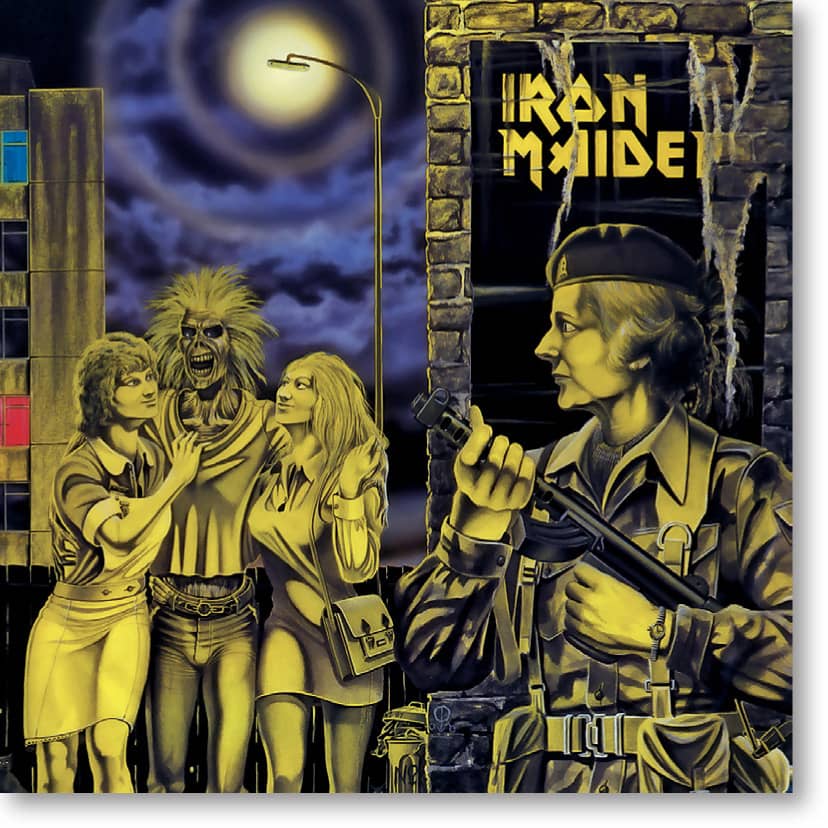
“Women in Uniform” (October 1980).
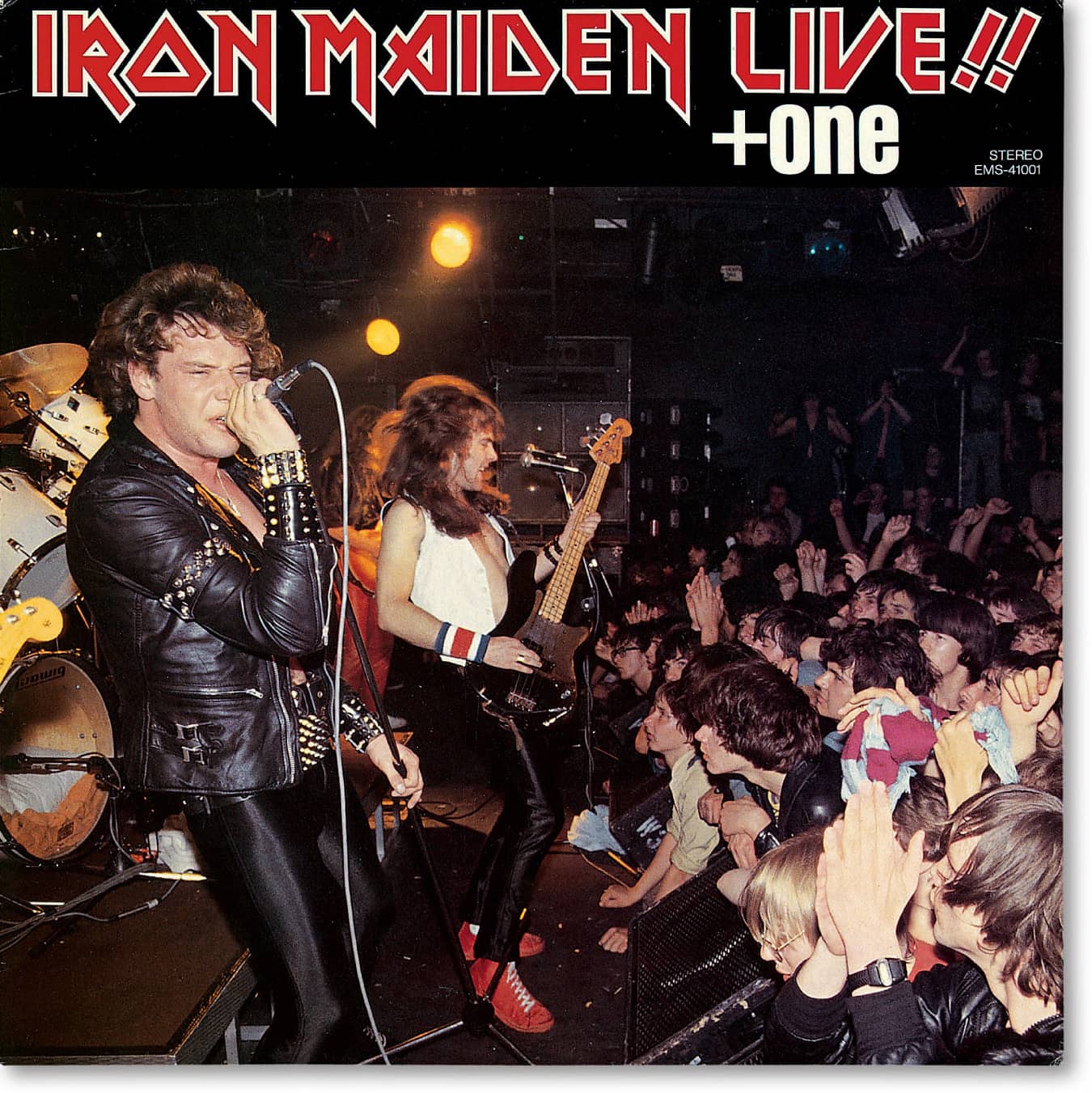
The Japanese EP Live!! + one (November 1980) featured four cuts recorded at the Marquee in London on July 4, 1980.
The Iron Maiden tour was split into two halves with the first part winding up in August. After finishing the first half of their own headlining tour, Maiden went out in support of KISS for the New York shock rockers’ Unmasked European tour, giving Maiden massive exposure outside of the United Kingdom. However, as soon as the KISS tour came to an end in October 1980, Dennis Stratton was out of the band over alleged musical differences. He was replaced by Adrian Smith, Dave Murray’s old mate.
Moving into the Maiden camp was a life-changing experience for Smith. “At first, it was all quite new to me because I’d never toured properly,” he explained to Chris Vinnicombe of musicradar.com in 2009. “I’d played clubs and pubs in England, playing from a couple of hundred people to a man and his dog! In the band I was in before Maiden [Urchin], I was going to gigs on the bus with my guitar and a plastic bag with my wah pedal in it. To go from that to earning a wage every week, having a tour bus, and playing in front of two to three thousand people, it was a huge novelty.”
With the KISS obligation complete, Maiden carried on with the second half of their own headlining tour from November through the end of the year. The full tour consisted of more than seventy shows, and the band was quickly building a reputation as a powerful live act.
It had taken the band quite some time to cement a fairly steady line-up. By now, Harris was the only member of the band to have played through every incarnation since their inception. “There’s been so many different changes,” he reflected in 1982 (Night Rock News). “We had so many changes before we actually went professional, ’cause, you know, they didn’t want to put money into the band, or they didn’t want to spend the time—that sort of thing…. Changes are a pain in the ass, but there’s no way you can carry on under certain circumstances. When you do make changes, you have to make sure they’re for the better. I think the changes we’ve made have been for the better—but then I’m biased!”
But those changes were far from over. Paul Di’Anno was becoming increasingly erratic and his seemingly out-of-control and wild persona were major causes for concern for Harris. Could Maiden continue with Di’Anno seemingly on a road to self-destruction? 

1979 By Ryan LaMar
02.15 |
Canning Town, GBR |
02.17 |
East Ham, GBR |
03.03 |
East Ham, GBR |
03.17 |
East Ham, GBR |
04.07 |
East Ham, GBR |
04.09 |
London, GBR |
04.23 |
Camden, GBR |
05.05 |
East Ham, GBR |
05.08 |
Camden Town, GBR |
05.11 |
East Ham, GBR |
05.18 |
Brighton, GBR |
05.19 |
Kingsbury, GBR |
05.25 |
Cambridge, GBR |
05.26 |
Guildford, GBR |
06.01 |
East Ham, GBR |
06.08 |
East Ham, GBR |
06.09 |
Kingsbury, GBR |
06.15 |
East Ham, GBR |
06.18 |
Canning Town, GBR |
06.22 |
Axminster, GBR |
06.29 |
East Ham, GBR |
07.?? |
Hammersmith, GBR |
07.02 |
Camden Town, GBR |
07.03 |
London, GBR |
07.14 |
Guildford, GBR |
07.16 |
Camden Town, GBR |
07.19 |
Hammersmith, GBR |
07.20 |
Norwich, GBR |
07.22 |
East Ham, GBR |
07.28 |
East Ham, GBR |
08.06 |
Camden Town, GBR |
08.10 |
London, GBR |
08.17 |
Birkenhead, GBR |
08.18 |
Tottenham, GBR |
08.19 |
Newbridge, GBR |
08.20 |
Camden Town, GBR |
08.24 |
London, GBR |
08.25 |
East Ham, GBR |
08.30 |
Swansea, GBR |
08.31 |
Aberavon, GBR |
09.01 |
Tonypandy, GBR |
09.03 |
Camden Town, GBR |
09.07–08 |
East Ham, GBR |
09.10 |
Camden Town, GBR |
09.14 |
London, GBR |
09.15 |
East Ham, GBR |
09.17 |
Camden Town, GBR |
09.27 |
Basildon, GBR |
09.28 |
Wolverhampton, GBR |
09.30 |
Camden Town, GBR |
10.03–04 |
Hammersmith, GBR (rescheduled from 09.06) |
10.05 |
East Ham, GBR |
10.06 |
Nottingham, GBR |
10.07 |
Trent Side, GBR |
10.08 |
London, GBR |
10.10 |
East Ham, GBR |
10.12 |
Gwent, GBR |
10.13 |
Manchester, GBR |
10.18 |
Manchester, GBR |
10.19 |
London, GBR |
10.26 |
Aberavon, GBR |
10.27 |
Tonypandy, GBR |
11.01 |
Aberdeen, GBR |
11.02 |
Blackpool, GBR |
11.05 |
Camden Town, GBR |
11.09 |
Aberavon, GBR |
11.10 |
Stroud, GBR |
11.12 |
Birmingham, GBR |
11.14 |
London, GBR |
11.16 |
Burton on Trent, GBR |
11.17 |
Liverpool, GBR |
11.19 |
London, GBR |
11.23 |
Birkenhead, GBR |
11.24 |
Warrington, GBR |
11.30 |
Middlesbrough, GBR |
12.01 |
Retford, GBR |
12.03 |
Birmingham, GBR |
12.04 |
Swindon, GBR |
12.07 |
London, GBR |
12.08 |
Bristol, GBR |
12.09 |
London, GBR |
12.10 |
Exeter, GBR |
12.15 |
Birmingham, GBR |
12.19 |
Camden Town, GBR |
12.21 |
Liverpool, GBR |
12.22 |
Oldham, GBR |
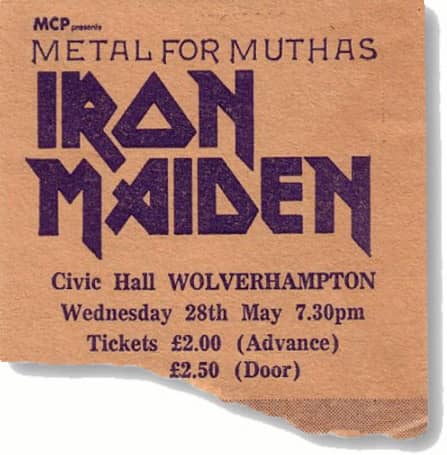
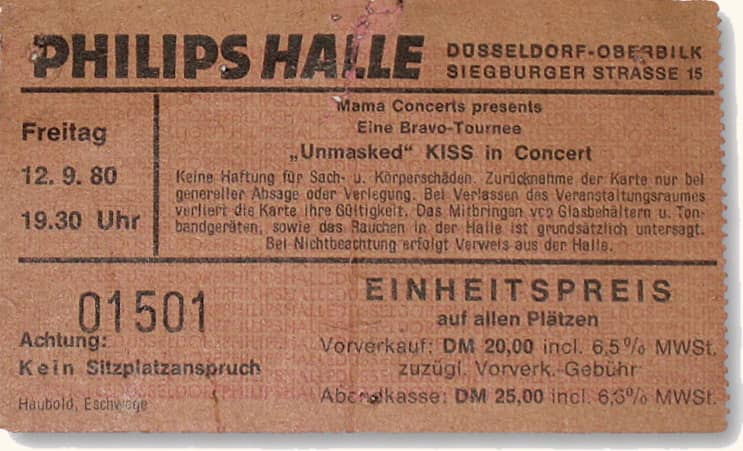
1980
02.01 |
Aberdeen, GBR |
02.02 |
Glasgow, GBR |
02.03 |
St. Andrews, GBR |
02.04 |
Edinburgh, GBR |
02.05 |
Grimsby, GBR |
02.06 |
Bristol, GBR |
02.07 |
Wakefield, GBR |
02.08 |
Huddersfield, GBR |
02.09 |
Manchester, GBR |
02.10 |
London, GBR |
02.11 |
Mansfield, GBR |
03.07 |
Cardiff, GBR |
03.08 |
Leeds, GBR |
03.09 |
Bristol, GBR |
03.10 |
Manchester, GBR |
03.11–12 |
Sheffield, GBR |
03.13 |
Leicester, GBR |
03.14–15 |
Hammersmith, GBR |
03.16 |
Southampton, GBR |
03.18 |
Aberdeen, GBR |
03.19 |
Edinburgh, GBR |
03.20–21 |
Newcastle, GBR |
03.22 |
Glasgow, GBR |
03.23 |
Deeside, GBR |
03.25 |
Stoke on Trent, GBR |
03.26–27 |
Birmingham, GBR |
04.01–03 |
London, GBR |
04.05 |
Kotrjik, BEL |
04.06 |
London, GBR |
04.07 |
Plymouth, GBR |
04.08 |
East Ham, GBR |
04.10 |
Grimsby, GBR |
04.14 |
East Ham, GBR |
05.15 |
Lincoln, GBR |
05.16 |
Newcastle, GBR |
05.17 |
Dunfermline, GBR |
05.18 |
Ayr, GBR |
05.19 |
Aberdeen, GBR |
05.20 |
Carlisle, GBR |
05.21 |
Bradford, GBR |
05.22 |
Withensea, GBR |
05.23 |
Cambridge, GBR |
05.25 |
Dunstable, GBR |
05.27 |
Blackburn, GBR |
05.28 |
Wolverhampton, GBR |
05.29 |
Hanley, GBR |
05.30 |
Swindon, GBR |
05.31 |
St. Austell, GBR |
06.01 |
Bristol, GBR |
06.02 |
Malvern, GBR |
06.04 |
Cardiff, GBR |
06.06 |
Cromer, GBR |
06.07 |
Birmingham, GBR |
06.08 |
Sheffield, GBR |
06.09 |
Liverpool, GBR |
06.11 |
Sunderland, GBR |
06.12 |
Dundee, GBR |
06.13 |
Glasgow, GBR |
06.14 |
Middlesborough, GBR |
06.16 |
Wakefield, GBR |
06.17 |
Leicester, GBR |
06.18 |
Chatham, GBR |
06.19 |
Guildford, GBR |
06.20–21 |
London, GBR |
06.22 |
Swansea, GBR |
06.24 |
Norwich, GBR |
06.25 |
Derby, GBR |
06.26 |
Manchester, GBR |
06.27 |
Bath, GBR |
06.28 |
Oxford, GBR |
06.29 |
Brighton, GBR |
06.30 |
Poole, GBR |
07.01 |
Portsmouth, GBR (possibly rescheduled from 06.03) |
07.03–05 |
London, GBR |
07.08–09, 11–12 |
London, GBR (these shows may not have happened) |
07.19 |
Oulu, FIN |
08.10 |
London, GBR |
08.21 |
Cromer, GBR |
08.23 |
Reading, GBR |
08.29 |
Rome, ITA |
08.31 |
Genova, ITA |
09.02 |
Milan, ITA |
09.04–05 |
London, GBR |
09.11 |
Nurnberg, GER |
09.12 |
Dusseldorf, GER |
09.13 |
Frankfurt, GER |
09.15 |
Dortmund, GER |
09.17 |
Stuttgart, GER |
09.18 |
Munich, GER |
09.20 |
Kassel, GER |
09.21 |
Brussels, BEL |
09.23 |
Avignon, FRA |
09.24 |
Lyon, FRA |
09.27 |
Paris, FRA |
09.28 |
Basel, SUI |
09.30 |
Cologne, GER |
10.01 |
Bremen, GER |
10.02 |
Hannover, GER |
10.04 |
Hamburg, GER |
10.05 |
Leiden, NED |
10.09 |
Stockholm, SWE |
10.10 |
Gothenburg, SWE |
10.11 |
Copenhagen, DEN |
10.13 |
Drammen, NOR |
10.?? |
Grimsby, GBR |
11.08 |
Munich, GER |
11.21 |
Uxbridge, GBR |
11.22 |
Leeds, GBR |
11.23 |
Redcar, GBR |
11.24 |
Hull, GBR |
11.25 |
Newcastle, GBR |
11.26 |
Birmingham, GBR |
11.27 |
Derby, GBR |
11.28 |
Hanley, GBR |
11.30 |
Manchester, GBR |
12.01 |
Nottingham, GBR |
12.19–21 |
London, GBR |
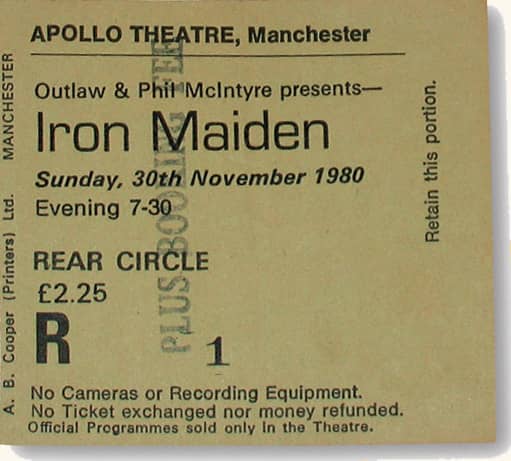
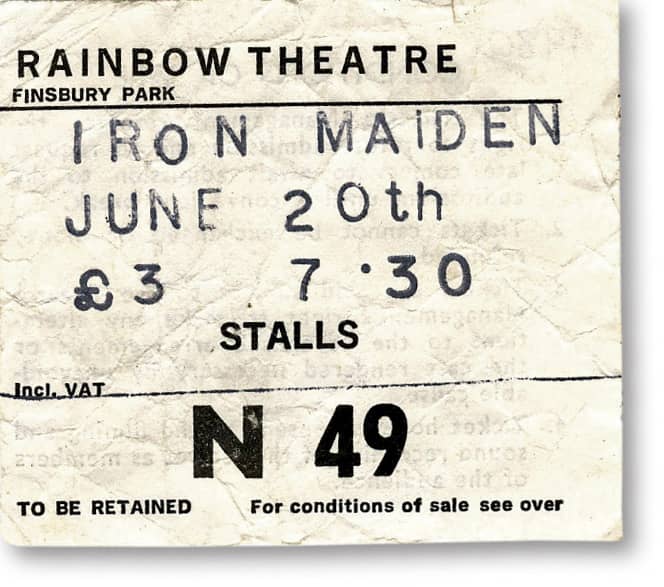
Notes: Six cancelled 1979 dates can be gleaned from Harris’ scrapbook in The History of Iron Maiden, Part 1: The Early Years. Per Skoog, a cancelled July 1979 date in London (day unspecified) was the result of an argument between manager Ron Smallwood and the pub owner.
The unidentifiable July 1979 date at Hammersmith is mentioned in Garry Bushell’s Running Free.
Seems likely the October 18, 1979, date never occurred but, rather, over the years some have misread the October 13 date as October 18 and perpetuated the latter.
According to the February 2, 1980, issue of Sounds, a string of February and March dates that year were axed so the band could record their debut LP. According to various sources, these numbered seventeen to nineteen from February 13 to March 2.
I have been able to locate absolutely no documenting evidence of the July 8–9 and 11–12, 1980, shows having taken place despite the band receiving excellent media coverage in London by this time.
The September 1980 London dates have been variously reported. Some sources list Maiden as playing on September 4–5 at the Marquee in London, and at least one other as possibly on September 5–6.
Per Gooch’s and Suhs’ KISS Alive Forever, seven dates of the 1980 KISS European tour were cancelled. One (Drammen, Norway) was rescheduled.
Bushell notes an October 1980 Grimsby date; Wall writes that the band fired Dennis Stratton after the previous Drammen date.
According to the December 6, 1980, Sounds, a November 29 show in Sheffield, England, was cancelled due to Paul Di’Anno’s throat infection.